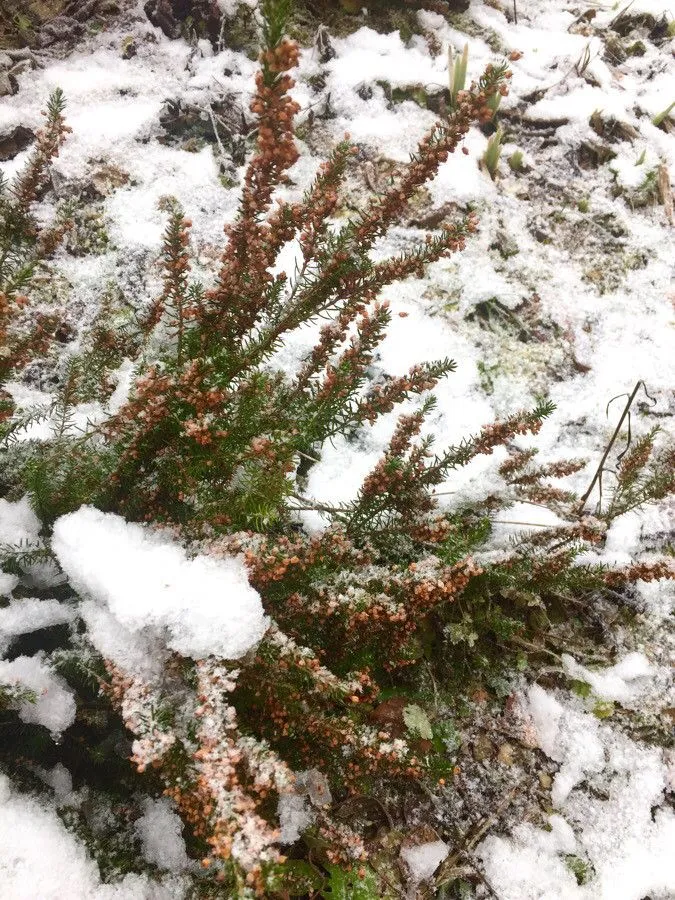
Author: L.
Bibliography: Erica: 10 (1770)
Year: 1770
Status: accepted
Rank: species
Genus: Erica
Vegetable: False
Observations: NC. Ireland, SW. England, W. & WC. France to N. Spain
Cornish heath, scientifically known as Erica vagans, is a beautiful and distinctive member of the Ericaceae family. First described in 1770 by the renowned botanist Carl Linnaeus, this plant is celebrated for its appealing clusters of small, bell-shaped flowers that add a splash of color to the landscapes it inhabits.
Erica vagans thrives primarily in regions with mild, maritime climates. Its natural distribution includes parts of NC Ireland, Southwest England, Western and West-Central France, and extends to Northern Spain. These regions provide the ideal conditions for the Cornish heath to flourish, typically featuring heathland environments with well-drained, acidic soils.
This heather species is particularly esteemed for its resilience and adaptability, making it a popular choice for gardeners seeking to add a touch of natural beauty to their outdoor spaces. The plant’s nectar-rich flowers attract a variety of pollinators, including bees and butterflies, contributing to the biodiversity and ecological health of the regions where it is found.
Cornish heath can be identified by its needle-like leaves and the dense spikes of tiny, bell-shaped flowers that vary in shades from soft pink to a deep, vibrant purple. Flowering typically occurs from late summer into autumn, providing a long-lasting display that brightens the heathlands and gardens alike.
In addition to its ornamental value, Erica vagans plays a significant role in its native habitats. It is a crucial component of the heathland ecosystem, providing shelter and sustenance to various wildlife species. Its robust nature allows it to thrive where many other plants might struggle, making it an important species for conservation and habitat restoration projects.
Overall, Cornish heath is not only a charming and attractive plant but also a vital part of the natural heritage of the regions it inhabits. Its enduring presence in both wild and cultivated settings underscores the botanical diversity and ecological richness of its native locales.
Eng: cornish heath
Deu: cornwall-heide
Swe: fransk klockljung
Cym: grug cernyw
En: Cornish heath
Ar: خلنج هائم
Eu: Txilar burusoil
Ca: Bruc vagant
Kw: Kykesow
Da: Høst-Lyng
Nl: Zwerfhelde, Zwerfheide
Et: Laiuv eerika
Fr: Bruyère Vagabonde, Bruyère voyageuse, Brande
Gl: Carrasca branca
De: Cornwall-Heide, Wander-Heide, Cornwall Heide, Mitsommer Heide, Wander-Erika, Wanderheide
Ga: Fraoch gallda
It: Erica vagabonda
No: Høstlyng
Pt-br: Urze
Ru: Эрика блуждающая
Es: Biércol, Brezo, Rubón
Sv: Fransk klockljung
Cy: Grug Cernyw
© copyright of the Board of Trustees of the Royal Botanic Gardens, Kew.
© copyright of the Board of Trustees of the Royal Botanic Gardens, Kew.
© copyright of the Board of Trustees of the Royal Botanic Gardens, Kew.
Taken Nov 25, 2018 by Victor Fuentes (cc-by-sa)
Taken Oct 28, 2017 by Philippe Feldmann (cc-by-sa)
Taken Dec 13, 2017 by Pep Secem (cc-by-sa)
Taken Dec 13, 2017 by Pep Secem (cc-by-sa)
Taken Dec 13, 2017 by Pep Secem (cc-by-sa)
Taken Feb 11, 2021 by francois tissot (cc-by-sa)
Taken Dec 17, 2015 by Tela Botanica − Liliane ROUBAUDI (cc-by-sa)
Taken Oct 24, 2017 by Yoan MARTIN (cc-by-sa)
Taken Jan 13, 2021 by Dieter Wagner (cc-by-sa)
Taken Jan 13, 2021 by Dieter Wagner (cc-by-sa)
Taken Dec 18, 2019 by Romero Germán (cc-by-sa)
Taken Nov 20, 2019 by Karim BOUDANI (cc-by-sa)
Taken Nov 1, 2019 by David LISZKOWSKI (cc-by-sa)
Taken Feb 15, 2018 by García Faustino (cc-by-sa)
Taken Dec 26, 2020 by Martínez Benavent Eva (cc-by-sa)
Taken Dec 15, 2020 by Dieter Wagner (cc-by-sa)
Taken Aug 3, 2020 by jid (cc-by-sa)
Taken Nov 1, 2019 by David LISZKOWSKI (cc-by-sa)
Taken Oct 27, 2020 by Ferguson Andy (cc-by-sa)
Taken Jan 13, 2021 by Dieter Wagner (cc-by-sa)
Taken Oct 24, 2017 by Yoan MARTIN (cc-by-sa)
Taken Nov 20, 2019 by Karim BOUDANI (cc-by-sa)
Taken Oct 23, 2022 by Barreda David (cc-by-sa)
Taken Oct 25, 2019 by Christophe Rocland (cc-by-sa)
Taken Dec 26, 2020 by Martínez Benavent Eva (cc-by-sa)
Taken Jul 15, 2011 by Photoflora – Benoit BOCK (©)
Taken Aug 24, 2021 by Thierry LE COM (cc-by-sa)
Taken Jul 29, 2021 by Alain Bigou (cc-by-sa)
Taken Sep 3, 2016 by Tela Botanica − Catherine ABDELOUADOUD (cc-by-sa)
Taken Oct 24, 2017 by Yoan MARTIN (cc-by-sa)
Growth habit: Subshrub, Shrub
Ph maximum: 5.5
Ph minimum: 5.0
Light: 8
Atmospheric humidity: 5
Bloom months: [‘aug’, ‘sep’, ‘oct’, ‘nov’, ‘dec’]
Soil nutriments: 2
Family: Myrtaceae Author: (F.Muell.) K.D.Hill & L.A.S.Johnson Bibliography: Telopea 6: 402 (1995) Year: 1995 Status:…
Family: Rubiaceae Author: Pierre ex A.Froehner Bibliography: Notizbl. Bot. Gart. Berlin-Dahlem 1: 237 (1897) Year:…
Family: Sapindaceae Author: Koidz. Bibliography: J. Coll. Sci. Imp. Univ. Tokyo 32(1): 38 (1911) Year:…
Family: Asteraceae Author: A.Gray Bibliography: Pacif. Railr. Rep.: 107 (1857) Year: 1857 Status: accepted Rank:…
Family: Fabaceae Author: Medik. Bibliography: Vorles. Churpfälz. Phys.-Ökon. Ges. 2: 398 (1787) Year: 1787 Status:…
Family: Aspleniaceae Author: (Cav.) Alston Bibliography: Bull. Misc. Inform. Kew 1932: 309 (1932) Year: 1932…